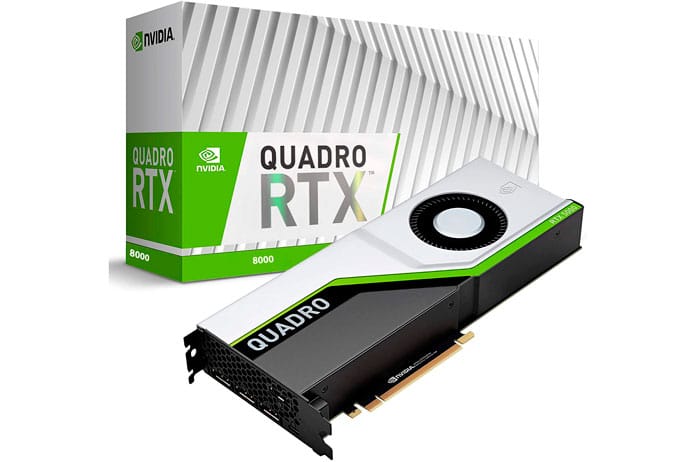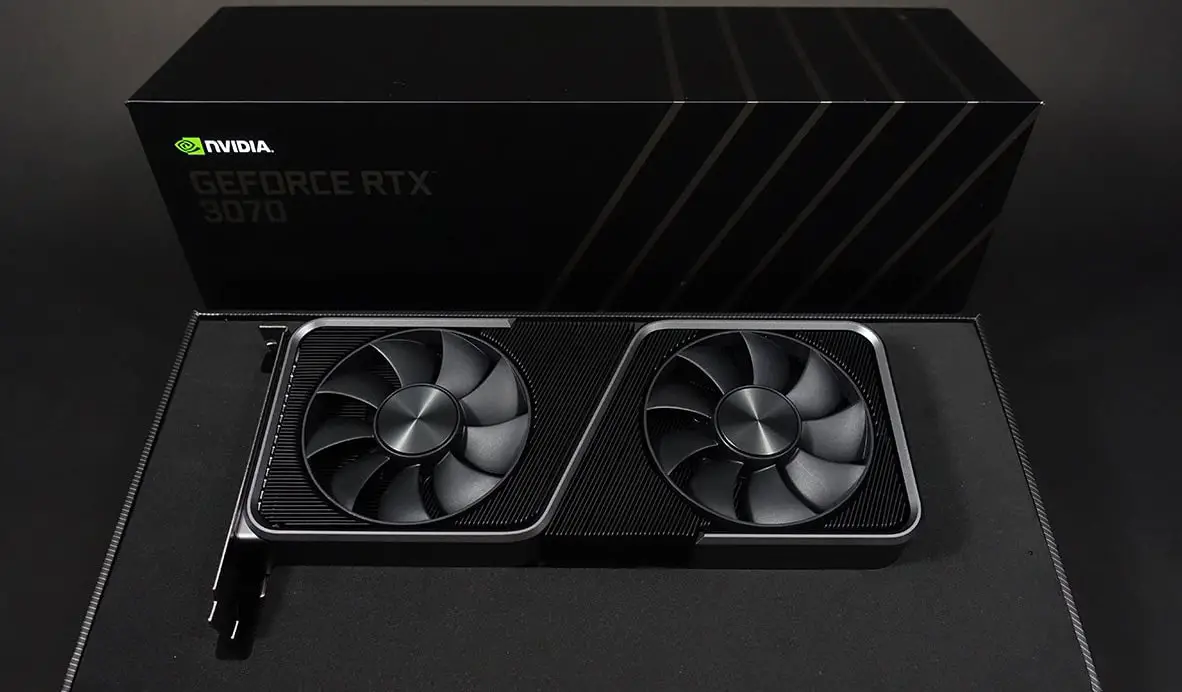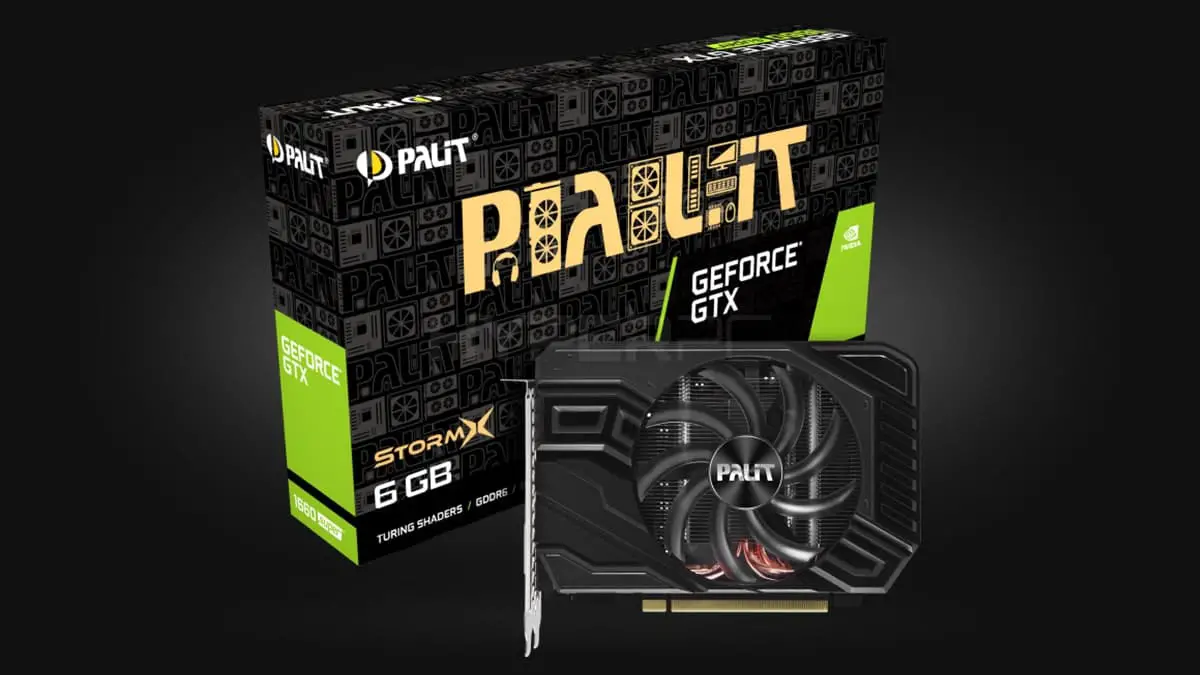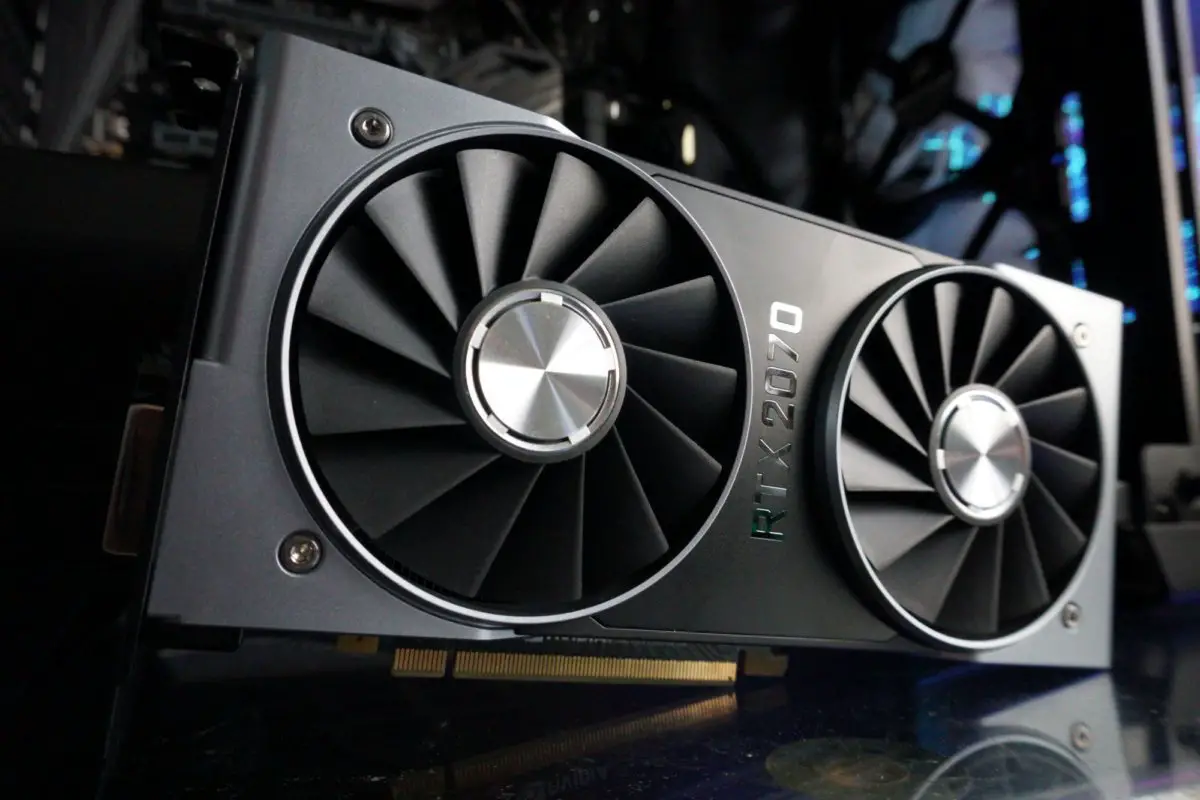PNY NVIDIA Quadro RTX 8000 48GB Graphics Card PNY NVIDIA Quadro RTX 8000 48GB Graphics Card was released on August 13, 2018 at a recommended price of $ 9.999. Now, in 2021, this professional video card costs about $5,500.
- In August 2018, NVIDIA Corporation announced its then-new Quadro RTX series at the SIGGRAPH conference.
For comparison, there are 3 graphics cards: Titan RTX, Quadro RTX 6000 and Quadro RTX 8000. These three graphics cards are based on the same Turing TU102 processor chip with all features enabled.
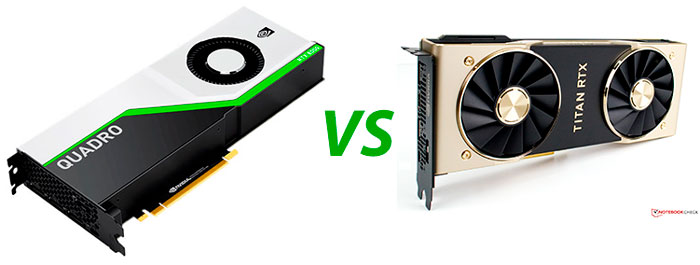
However, the Quadro RTX family is designed for highly demanding professional applications. Memory is different for all species.
Considered in the review PNY NVIDIA Quadro RTX 8000 48GB graphics card Provides support for ECC (Automatic Memory Error Correction) – a required feature in some industries.
- After all, God forbid some kind of failure and all expensive equipment will fail, which will entail multi-million dollar losses …
While the memory for the Titan RTX and Quadro 6000 is 24GB, the Quadro RTX 8000 doubles that capacity to 48GB !!!
NVIDIA Quadro RTX 8000 48GB is a true professional graphics card
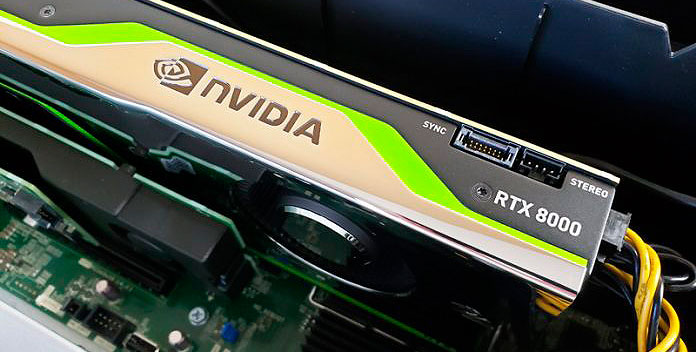
GPU NVIDIA Quadro RTX 8000 48GB Is a professional graphics card released on August 13, 2018.
- The card is based on the 12nm process technology and is based on the TU102 GPU in the TU102-875-A1 variant.
Supports DirectX 12 Ultimate. The GPU TU102 is a large chip with a matrix area of 754 mm2 and 18 600 million transistors.
It contains 4608 shaders, 288 texture mappings, and 96 ROPs. Also included are 576 Tensor Cores to help speed up machine learning applications.
The card also has 72 ray tracing acceleration cores. NVIDIA has paired 48GB of GDDR6 memory with a Quadro RTX 8000, which are connected using a 384-bit memory interface.
The video card runs at 1395 MHz, which can be increased to 1770 MHz, the memory runs at 1750 MHz (effectively 14 Gbps).
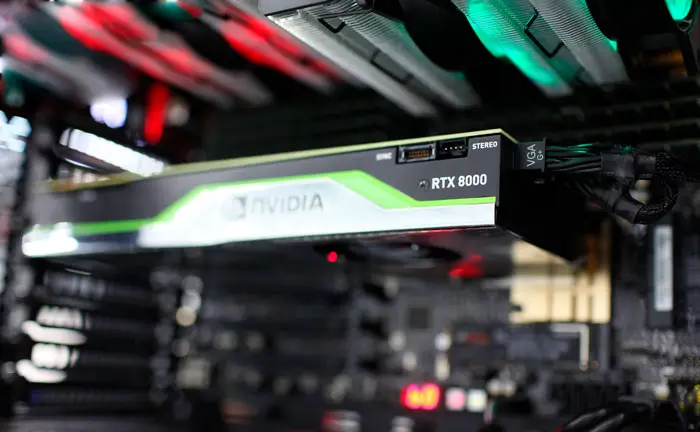
- Being a card with two slots, NVIDIA Quadro RTX 8000 48GB Powered by a 1x 6-pin + 1x 8-pin power connector with a maximum output of 260W.
The Quadro RTX 8000 connects to the rest of the system using a PCI-Express 3.0 x 16 interface. The card is 267mm long, 111mm wide and features a dual-slot cooling solution. Its launch price was about $ 9.999.
Putting it into perspective, even NVIDIA’s high-performance datacenter chips, including the latest NVIDIA Tesla V100S, only have 32GB.
For many PNY NVIDIA Quadro RTX 8000 48GB graphics card today is the absolute pinnacle of GPU technology.
PNY NVIDIA Quadro RTX 8000 48GB graphics card Specifications:
- Codename – TU102;
- Launch date – August 13, 2018;
- Starting price – $ 9.999
- Core clock speed – 1005 MHz;
- Increase up to 1200 MHz;
- System Memory – 48GB GDDR6;
- Max. memory bandwidth – 672 GB / sec;
- Memory clock speed 14000 MHz;
- Technical process – 12 nm;
- Memory bus width – 384 bits;
- Shader ALU – 4608;
- Texture blocks – 288;
- Rasterization blocks – 96;
- Shaders version – 5.1;
- PCIe interface – 3.0 x16;
- Ray tracing support – yes;
- Max. resolution – 8K UHD (Ultra HD), 7680 x 4320;
- Max. number of monitors simultaneously – 4;
- Additional power supply – 8 pin + 6 pin;
- Heat Dissipation (TDP) 250 W;
- Recommended power supply unit – min. 650 watts;
- The number of transistors – 18.600 million;
- Video Outputs and Ports – 4 x DisplayPort, 1x USB Type-C display connectors;
- Length – 267 mm;
- Thickness – 40 mm;
- Additional power connectors – 2 x 8-pin;
- API support;
- DirectX 12.0 (12.1);
- OpenGL 4.6.
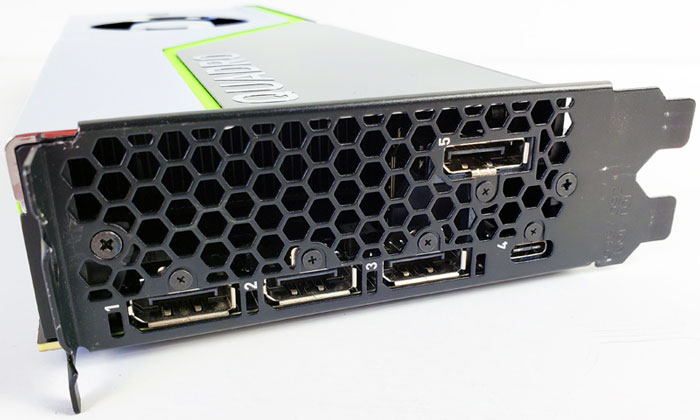
Beautiful graphics card with 1 fan
The NVIDIA Quadro RTX 8000 48GB graphics card is a 10.5-inch dual-slot GPU. The outer casing is very stylish, with a shiny chrome finish and a bright green stripe in the middle.
- It is a nice looking graphics card. Cooling configurations differ between the Titan RTX and RTX 8000. The first graphics card uses a dual fan cooling system, while the Quadro RTX 8000 has only 1 cooler.
Typically, dual fan cooling solutions work well in single or dual GPU configurations. But there are times when it is still preferable to have 1 cooler for a video card.
The Titan RTX has a rear panel that looks pretty in general, while the Quadro RTX 8000 does not. Of course, I would like to see the presence of a back panel even on OEM cards. But you see they saved))
On the video card NVIDIA Quadro RTX 8000 48GB we find the video outputs which are DisplayPort 1.4 and a VirtualLink port for VR.
The video card is very competently and neatly assembled – nothing extra
Professional imaging is definitely within the purview of the Quadro RTX 8000, so having a lot of video outputs is important.
The power connections are located at the end of the Quadro RTX 8000 graphics card. This is another major departure from consumer offerings to professional ones.
- The graphics card has neat cable routing for the front and rear structures for good airflow.
Whether you have a high-end desktop workstation or a virtual workstation located in the data center, the Quadro RTX 8000 is designed with every use case in mind.
Also Quadro card, RTX 8000 supports Quadro Sync II cards, which allow synchronization of up to 32 cards on 8 GPUs for large “video walls”.
How many professional video cards are mining?
Hello everyone, dear friends. Glad to see you! Today let’s look at how many professional video cards are mined, which cost several times more than gaming ones. Let’s start!
By the way, I still have YouTube and Telegram , don’t forget to subscribe!
And what is “professional”?
I have already written many times how professional video cards differ from non-professional ones. If not prof. the map is designed to perform a large number of simple tasks (building 60 relatively simple frames), but a professional map is designed to calculate and display a large amount of information with great accuracy within one frame.
Let me explain more simply – a gaming video card – 60 frames with 10,000 polygons per second (we neglect shading and lighting). Professional Map – Renders one frame with incredible precision (1,000,000,000 polygons) without any time constraint.
But they have the same GPU.
That’s right – gaming and professional video cards are based on the same GPU, but there are differences: drivers, support, standardization, and so on. Prof. cards, in principle, you can play, but the FPS will be slightly lower, since the card was originally designed for miscalculations. After the word “miscalculations” every second miner’s eyes lit up.
After all, mining is exactly what the calculations that the video card performs – the number of solutions (hashes) per second. For example, 30 megahashes per second equals 30 million block solutions. But such a hash rate is shown by gaming video cards, but what about professional ones? After all, they are now almost equal in price with the game ones, which means – maybe this is a way out? Let’s see.
Nvidia Quadro RTX 8000
The characteristics of this card are as follows:
- CUDA kernels – 4608
- NVIDIA Tensor Cores – 576
- RT cores – 72
- Video Memory – 48GB GDDR6 with ECC memory support
- RTX Operations – 84T
- Number of beams – 11 billion beams / s
- Single precision computing performance – 16.3 Teraflops
- Maximum power consumption – 295 W
You can see the cost below:
These characteristics are painfully familiar, aren’t they? This card is based on the same chip as in the 2080Ti, but a little more “improved” – more cores, and therefore a little better performance. And what about the hash rate?
55 Mh / S is the level of a regular RTX 3060, which is 5 times cheaper than this card. Already here we can conclude that there is no point in mining on the prof. maps, but the Quadro RTX 4000 has been googled many, many times. Let’s take a look at her.
Are the cheaper cards doing better?
And so, the Nvidia Quadro RTX 4000 has the following specifications:
- CUDA kernels – 2304
- NVIDIA Tensor Cores – 288
- NVIDIA RT cores – 36
- Video Memory – 8 GB GDDR6
- Number of RTX Operations – 43T
- Number of beams – 6 billion beams / s
- Performance in single precision operations – 7.1 TERAFLOPS
- Maximum power consumption – 160 W
But here everything is more interesting, since the closest “gaming relative” of this card is the RTX 2070, with the only difference that prof. lower frequency cards as well as GPU. With similar specs, the Quadro RTX 4000 builds on the stripped-down TU104 while the 2070 builds on the TU106. However, what’s the hash rate?
And this is where everything seems to be pretty good, because for around $1,200 we get the level of RTX 2070. True, there is one problem: the RTX 3060 can be found for around $1,100 and it already digs at 50 Mh / S (Mining Hashrate).
5 video cards for mining 2020, payback calculation and card characteristics – an overview
We present an overview of inexpensive video cards for crypto mining with a forecast of their payback. Today, the cryptocurrency mining market continues to grow rapidly, no matter what. Cryptocurrency miners are back in business, but which video card to choose so as not to be left with an empty wallet. Let’s consider in the review which manufacturers offer the best video cards on the market and which cards are suitable for certain types of cryptocurrency mining.
Bitcoin or ether, which is better to mine?
Regarding the choice of cryptocurrency for mining in 2020, there have been no significant changes. This year, most video cards can still mine Ether (ETH) or forks. As for bitcoins (BTC), mining the world’s first cryptocurrency ceased to be available to ordinary people a few years ago, as it requires serious investments, special equipment and access to large amounts of cheap electricity.
This is all the more relevant now, since Bitcoin (BTC) mining is generating half of the revenue after the reward was cut in half in May. Mining difficulty continues to grow, and in September it hit an all-time high of $ 19.31 trillion at block 649152.
As a result, many popular devices like the Antminer S9 are outdated. After halving, the most profitable miners were Whatsminer M30S ++ from the Chinese company MicroBT, which can provide hash rates of up to 112 terahashes per second and generate a profit of just over $ 8.50 per day, as well as Antminer S19 Pro from Bitmain, which can reach hash rates of 110 TH / s and get a daily profit of just under $ 8.50.
But the prices for this hardware are pretty steep: A Whatsminer M30S ++ costs $ 1800, while Antminer S19 Pro comes in at $ 2407.
When it comes to ether and its forks, GPU mining is gaining popularity again for several reasons. Firstly, over the past two years, the Ethereum hash rate has decreased by 15% (compared to August 2018) and now stands at 256,221 TH / s. This means that it is now easier to obtain ether.
Secondly, both modern and old card models can still be used for mining. For example, the Nvidia 1050 Ti released in October 2016 and the Radeon RX 580 released in April 2017 are still very popular.
Prices for such old cards are constantly dropping as new cards are released, which encourages miners to return to the market. But most importantly, the price of ETH has tripled from early 2020 to early September, making Ether still very profitable to mine.
There is another factor that attracts the interest of miners: the upcoming transition to Ethereum 2.0 and the Proof-of-Stake algorithm, which is expected to begin before the end of the year.
“In this cycle, we can expect further expansion of DeFi projects, which in turn will make the ETH network more and more popular. As a result, the block reward for ETH (part of the commission) should cyclically increase with an overall upward trend, which will make ETH mining the most profitable for GPU miners. “
Which video card to choose
After testing the graphics cards of the two largest manufacturers, Nvidia and AMD, Nvidia graphics cards performed better. However, given the fact that Ether mining has received a second life, AMD cards should not be discounted as the company’s Vega and RX generations are still very suitable for Ethash algorithms.
Regardless of the manufacturer, the most important factor is the return on investment, as any miner must first put in a decent amount of money before making any profit.
The standard installation requires six graphics cards, and as a result, a miner can spend over $ 9,000 buying the popular Nvidia RTX 2080 Ti with 8 or 11 GB of RAM. But what about those who cannot afford the upper bar, but still want to make a profit?
1) Nvidia GTX 1660 Super
This card was released in October 2019, which means the technology is still fresh. The graphics card has 6 GB of memory and a Turing architecture that runs at higher clock speeds, uses less power and has 20% better performance than the GTX 1660. The price of this model ranges from $ 240 to $ 250.
2) AMD Radeon RX 5700 and RX 5700 XT
In the summer of 2019, AMD introduced a new line of RX 5700 series graphics cards to the market. These cards use FinFET technology, which provides better energy efficiency in mining due to the reduced size of electronic components and lower current consumption.
RX 5700 specifications include 8GB GDDR6 memory and 180W power consumption. The RX 5700 XT has a power consumption of 225W, but the base clock is also 10% higher than the RX – 5700. These cards are slightly more expensive at around $ 430, but they can be purchased at a discounted price around $ 400.
3) Nvidia RTX 2060 Super
The RTX 2060 Super card may not be an obvious choice, since apart from 8GB of memory, it is no different from the RTX 2060. But at the same time, it uses five different algorithms – GrinCuckarooD29, GrinCuckatoo31, DaggerHashimoto, X16Rv2 and BeamV2 – making it more stable. safe and suitable for mining.
It’s actually an intermediate option between the RTX 2060 and RTX 2070, but can be found online for as little as $ 399, while the RTX 2070 will cost you around $ 530, and the $ 130 difference is serious money in this business.
4) AMD Radeon RX 580
AMD RX 580 was released back in 2017 and is still one of the best low budget GPUs for mining, with prices ranging from $ 180 to $ 230. The card is mainly used for ether mining and has 8 GB of memory, but it consumes little power – only 150 watts
The only potential competitor might be the RX 570, but a card with 4GB of storage will no longer be able to do that. get ether in 2021.
5) Nvidia P106-100
Nvidia has a special series of graphics cards for mining cryptocurrencies – the Mining edition The Nvidia P106-100 is based on the Nvidia GP106 GPU (Geforce GTX 1060), which is almost the same as the regular Geforce GTX 1060, but with some minor changes. The P106-100 has no video outputs or rear panel, and the card is equipped with 6GB of memory.
The mining edition in the name does not mean that the new product is better at mining than the regular version, but rather that it is designed specifically for miners, since everything that was considered insignificant has been removed, which allows it to be sold for about $ 320 at $ 170 cheaper than the GTX 1060.
What is the payback of video cards
How long will it take for these budget cards to recoup the starting price? In comparison, one of the most popular mining cards today, the Nvidia RTX 2080 Ti, brings in around $ 1.66 per day when mining Ether. If you buy this video card at an average price of about $ 1400, it will take about 28 months to payback, excluding the cost of electricity.
So, here’s what the calculations say:
The Nvidia GTX 1660 Super , which can be purchased for $ 240, will bring in $ 0.65 per day and pay off in 12 months.
AMD Radeon RX 5700 XT costs $ 400, payback period is 8.5 months, while bringing in $ 1.56 per day.
The Nvidia RTX 2060 Super can be purchased for $ 399 and will bring in $ 0.92 per day when mining Ether. This card will pay off in 14 months.
The Radeon RX 580 is a very popular card due to its rather low price – around $ 200, and this card will pay off in just 7 months, bringing in almost a dollar – $ 0.96 per day.
Built specifically for mining, the Nvidia P106-100 will bring in $ 0.85 per day, and at $ 320 will pay off in just over 12 months.
* However, this is not an exact science, and every miner should keep in mind that the algorithms of any cryptocurrency are constantly becoming more complex, which makes mining difficult and increases the payback time of the equipment invested in mining.
What new graphics cards are on the horizon
With the hype around decentralized finance, a crypto boom looms again on the horizon, and new products to come may propel it further. Nvidia launched the next generation GeForce RTX 3000 graphics cards in September, and some pros have already said that they can produce 81-89 MH / s while mining.
The high-end model, the GeForce RTX 3090, is expected to demonstrate 120-122 Mh / s. If this is the case, then Nvidia could face a shortage of cards, as miners will buy everything, leaving gamers with nothing.
But AMD is not far behind and will unveil the Radeon RDNA 2 lineup in late October, which will compete directly with Nvidia’s 3000 series. The emergence of new cards will be of great interest to the cryptocurrency miner community. Andrey Shkraba, Head of Marketing at NiceHash, a platform for mining and trading cryptocurrencies, is confident that technological innovations from AMD and Nvidia will increase productivity:
“Nvidia just released the 3000 series, but availability is very low at the moment. The new RTX cards will provide higher hash rates and miners will be upgrading their older 1060 cards and older AMD (480/580) cards. We still have to wait for AMD’s announcement to see what they bring to the market. “
Dell nvidia quadro rtx8000 video card how many mines
Hello everyone, dear friends. Glad to see you! Today let’s look at how many professional video cards are mined, which cost several times more than gaming ones. Let’s start!
By the way, I still have YouTube and Telegram , don’t forget to subscribe!
And what is “professional”?
I have already written many times how professional video cards differ from non-professional ones. If not prof. the map is designed to perform a large number of simple tasks (building 60 relatively simple frames), but a professional map is designed to calculate and display a large amount of information with great accuracy within one frame.
Let me explain more simply – a gaming video card – 60 frames with 10,000 polygons per second (we neglect shading and lighting). Professional Map – Renders one frame with incredible precision (1,000,000,000 polygons) without any time constraint.
But they have the same GPU.
That’s right – gaming and professional video cards are based on the same GPU, but there are differences: drivers, support, standardization, and so on. Prof. cards, in principle, you can play, but the FPS will be slightly lower, since the card was originally designed for miscalculations. After the word “miscalculations” every second miner’s eyes lit up.
After all, mining is exactly what the calculations that the video card performs – the number of solutions (hashes) per second. For example, 30 megahashes per second equals 30 million block solutions. But such a hash rate is shown by gaming video cards, but what about professional ones? After all, they are now almost equal in price with the game ones, which means – maybe this is a way out? Let’s see.
Nvidia Quadro RTX 8000 Features
The characteristics of this card are as follows:
- CUDA kernels – 4608
- NVIDIA Tensor Cores – 576
- RT cores – 72
- Video Memory – 48GB GDDR6 with ECC memory support
- RTX Operations – 84T
- Number of beams – 11 billion beams / s
- Single precision computing performance – 16.3 Teraflops
- Maximum power consumption – 295 W
You can see the cost below:
These characteristics are painfully familiar, aren’t they? This card is based on the same chip as in the 2080Ti, but a little more “improved” – more cores, and therefore a little better performance. And what about the hash rate?
55 Mh / S is the level of a regular RTX 3060, which is 5 times cheaper than this card. Already here we can conclude that there is no point in mining on the prof. maps, but the Quadro RTX 4000 has been googled many, many times. Let’s take a look at her.
Are the cheaper cards doing better?
And so, the Nvidia Quadro RTX 4000 has the following specifications:
- CUDA kernels – 2304
- NVIDIA Tensor Cores – 288
- NVIDIA RT cores – 36
- Video Memory – 8 GB GDDR6
- Number of RTX Operations – 43T
- Number of beams – 6 billion beams / s
- Performance in single precision operations – 7.1 TERAFLOPS
- Maximum power consumption – 160 W
But here everything is more interesting, since the closest “gaming relative” of this card is the RTX 2070, with the only difference that prof. lower frequency cards as well as GPU. With similar specs, the Quadro RTX 4000 builds on the stripped-down TU104 while the 2070 builds on the TU106. However, what’s the hash rate?
And this is where everything seems to be pretty good, because for 100,000 rubles we get the level of RTX 2070. True, there is one problem: the RTX 3060 can be found for 80,000 rubles, and it already digs at 50 Mh / S.
Conclusion
We can say that mining on professional video cards is such a pleasure. With the help of overclocking, you can achieve a better result, but it makes no sense to buy them purely for mining, since there is a much more affordable RTX 3060.
But if for some reason you really want to get a professional video card for your farm – please, now you know what income the most popular cards of this type have. If you want, I’ll tell you about how many all current professional video cards are mined (maybe there will be something interesting there).





